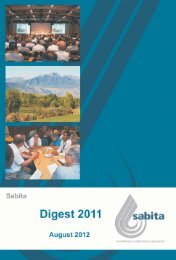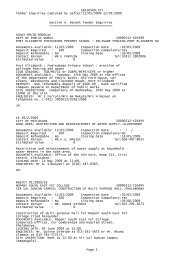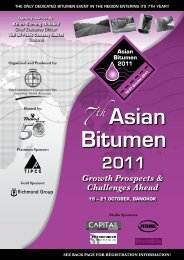DIGEST 2006 - Sabita
DIGEST 2006 - Sabita
DIGEST 2006 - Sabita
Create successful ePaper yourself
Turn your PDF publications into a flip-book with our unique Google optimized e-Paper software.
A viable alternative to natural aggregates:<br />
The use of steel slag aggregate<br />
in asphalt mixes<br />
Hugh Thompson<br />
Director<br />
WSP SA Civil and<br />
Structural Engineers<br />
(Pty) Ltd<br />
Michael Bouwmeester<br />
Associate<br />
WSP SA Civil and Structural<br />
Engineers (Pty) Ltd<br />
Far from being a waste<br />
product of the steel<br />
production process, steel<br />
slag is a high quality resource<br />
for use as an aggregate in road<br />
construction, and as such it<br />
should be seriously considered<br />
as a viable alternative<br />
aggregate in hot mix asphalt.<br />
Due to the changes in traffic<br />
loading spectra and higher road<br />
surface temperatures being<br />
experienced in South Africa,<br />
numerous investigations have<br />
been undertaken to assess the<br />
properties of asphalt mixes to<br />
improve durability, and resistance<br />
to fatigue fracture and<br />
deformation. One such<br />
investigation examines the use of<br />
steel slag as an aggregate in<br />
asphalt mixtures.<br />
As a result of increasing focus on<br />
the environmental requirements<br />
for the acceptable disposal of<br />
waste slag, as well the<br />
considerable strain on the already<br />
limited number of aggregate<br />
resources, steel slag is being<br />
increasingly considered as an<br />
alternative to natural aggregates<br />
in the road construction industry.<br />
Slag production<br />
Steel slag is produced during the<br />
separation of molten steel from<br />
impurities in steel-making<br />
furnaces, and is composed of<br />
calcium silicates together with<br />
oxides and compounds of iron,<br />
manganese, alumina and other<br />
trace elements.<br />
Free lime and magnesium oxides<br />
that have not reacted with the<br />
silicate structures can hydrate and<br />
expand in humid environments,<br />
which is precisely what happens<br />
with steel. Consequently, slag<br />
aggregates exhibit a tendency to<br />
expand. Volume changes of up to<br />
10% or more, attributable to the<br />
hydration of calcium and<br />
magnesium oxides, can cause<br />
difficulties.<br />
For this reason it is important that<br />
further weathering of the steel<br />
slag takes place to cause the free<br />
calcium oxide to hydrate. If the<br />
73
















